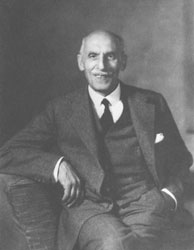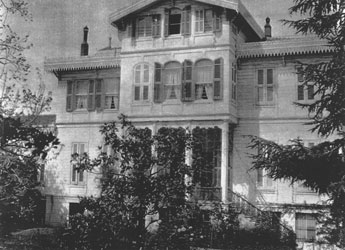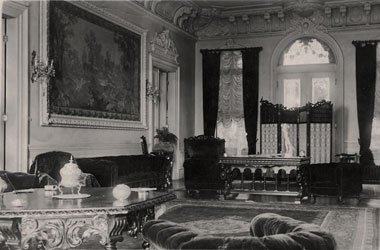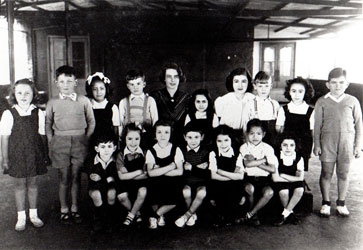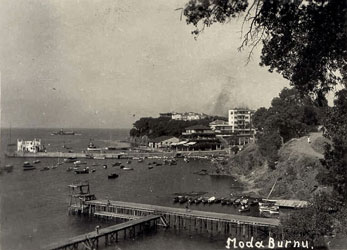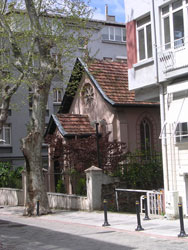I was born in Istanbul in 1944 to Roland (1915-2004) and Lily (née Williams, 1914-2004) Whittall. Roland James La Fontaine Whittall was the eldest son of James Frederick Whittall (1890-1981), who was the eldest son of Frederick Edwin Whittall (1864-1953) who in turn was the eldest son of Sir James William Whittall (1838-1910), one of the first Whittalls to move from Smyrna (Izmir) to Constantinople (Istanbul).
As compared to the rest of the Whittall clan who lived in Moda, my parents lived in Taksim, on the European side of the Bosphorous. The reason was two fold: my Mother had been brought up and worked on the European side and my Father, who was a polio victim from the age of 6, also worked “in Europe” and this made travelling for him rather easier. We lived in an apartment in Topçular Caddesi with my maternal Grandmother (Angelina Genovese 1899-1960). My Mother did not work after I was born, followed two years later by the arrival of my sister, Jennifer.
As far as I can remember, each Sunday we would go across to Moda to have lunch with my grandparents, James and (Lydia) Mary (La Fontaine) Whittall. In the early days they lived in Twee Cottage, Moda Çıkmazı, and later in Yusuf Kâmil Paşa Sokak, opposite All Saints Church. After their deaths, the Yusuf Kâmil Paşa Sokak house was sold to the musician Barış Manço and following his death it has become a museum in his memory.
Most summers, we would leave Taksim and head to Moda or Fenerbahçe to escape the heat. When Jennifer and I were really tiny, Mum and Dad would rent a house in Mektep Sokak which had a garden and was not far from the swimming facilities of the Karışık Banyolar [mixed baths] and later, when Jennifer and I were old enough (and probably not wise enough to be allowed there on our own), the Kadınlar Banyoları. The Karışık Banyolar catered for both sexes and had a large sandy area, ideal for youngsters. The Kadınlar Banyolar, for women only, was an enclosed wooden construction with changing cabins around a wooden platform for sunbathing with a couple of wooden ladders allowing the older women to get into the sea sedately, while the younger ones just jumped – splashing one and all.
Frederick Edwin Whittall CBE of Moda, Istanbul of J.W. Whittall & Co. (1864-1953) |
The front of Frederick Edwin’s house in Moda |
A corner of the hallway of Frederick Edwin’s house in Moda |
Later on, after my great-grandfather, Frederick Edwin Whittall, had died, we spent a couple of summers in the house – on the first floor, as Dad only had the marble steps to negotiate to enter the house. The gardens were huge and paradise for us children. At least once, Grandpa Edwin’s youngest daughter, Edythe Thompson who normally lived in Alexandria, came to Istanbul to escape the Egyptian heat and used the level above with her husband, Hugh Thompson, and their two children, Sally and John. At the top of Grandpa Edwin’s property were a couple of lodges, and we spent a couple of summers there as well. The riots of the night of 6-7th September 1955 when foreign property was badly damaged happened when we were in one of the lodges, and whilst being completely unaware of what was happening in the rest of town, Mum and Dad watched the throngs heading towards Kadıköy. What they only discovered the following morning was the devastation, a great deal of it directed towards the Greek community.
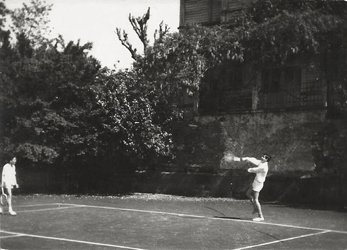 |
In the very early days, when Jennifer and I were very young, we would go to my grandparents on Christmas Eve and return late on Christmas Day. Jennifer and I would sleep in the guest bedroom in a double bed with a bolster down the middle (!) while our parents slept on the sofa and a camp bed! Needless to say, Santa Claus was the reason for this arrangement, and Jennifer and I would slide down the bed and wiggle our toes to see if he had been. Sometimes the stockings (actually, navy blue silk pillow cases) would be opened around 5 am (much to the chagrin of the older members of the family who wanted their sleep but were wakened by the noise in the spare bedroom). Our main presents would be opened on Christmas Eve after singing Christmas carols around the Christmas tree in the drawing room, with Granny occasionally playing the piano. On Christmas Day, after going to church, we would do the rounds of the various aunts and uncles (some were not related but respect was important in those days), wishing them Merry Christmas and collecting so many presents that my Mother would tear her hair out as to where to store them!
Jennifer and I were educated at the English High School for Girls, where the headmistress at the time was a distant relation, Estelle Thompson. She was a formidable but fair headmistress who maintained discipline with an iron rod. Whether it was to be congratulated for some excellent work, or to be told off for misbehaviour, standing in line outside her study at break time was a daunting experience. One abiding memory for me was being caught out during a Turkish history lesson imitating the lion in the film trailer of Metro Goldwyn Meyer. I was sent out of the classroom and made to stand in the corridor. Much to my horror, Miss Thompson turned up! I was told off – and, if I remember correctly, had a Saturday morning detention to follow! (funeral tribute to Miss Thompson).
The English High School for Girls had two distinct parts to it: the junior school and the senior school. The junior school was only open to children (boys as well) of foreign parents: locals, like Jennifer and me, and the children of ex-patriot families who were working in Turkey for a few years. The law required children whose parents were Turkish to go to Turkish junior schools. Schooling started at age 5 with kindergarten, age 6 with transition and aged 7 with proper learning. Junior school ended age 12 after which we progressed to senior school. However, each year about 25 to 30 Turkish children would sit entrance exams for the English High School for Girls (there were also French, Italian and German schools from which to choose). The successful entrants would then have two years, Special B followed by Special A, where they had intensive English lessons, before joining the junior school graduates. This of course meant the Turkish girls were always 2 years older than the foreign girls.
The English High School for Girls for the school year 1950-51 |
Year group c. 1953. |
Secondary education was completed at age 16 for us and 18 for the Turkish girls. GCE was not available at school, but I took some subjects with private tuition and the exams were sat at the British Council offices, just off Ayazpaşa.
Once GCE exams were over, I went to London, accompanied by my grandparents, James and Mary, and spent the next year at the Denson Secretarial College in Queensgate, London. Between September 1961 and July 1962, I became proficient in shorthand and typing, banking and economics(!), bookkeeping and even French shorthand. I also learned to drive and passed my test at the first attempt.
One of the highlights of childhood and teenage years in Istanbul was the visit to the British Royal Navy. There would be children’s parties held on board one of the ships and later, cocktail parties on board as well as dances at the British Consulate. The whole of the British community would be involved in these visits and just about the whole of Istanbul would turn up at Dolmabahçe to watch Beating Retreat. Whilst the sailors would be on duty at the children’s parties, a number of mothers would also be recruited to assist. The year that my Mother was on board (think I was about 10), she lost me! I had come down a slide and managed to cut my right hand between the ring and little fingers. Needless to say, I was a bit bloodstained, so was taken down to the Medical Centre into the bowels of the ship to be stitched up! My mother’s concern was partly about the hand and partly as to whether I would be able to write properly as the naval visit coincided with exam time at school – the education system in Turkey stipulated exams each year in June and if you succeeded in each subject, you went up to the next class! If necessary, you could re-take up to two failed subjects in September, but if you failed more than two, you repeated the year.
As we grew up and started socialising without parental supervision, one had to beware of a newspaper known as Le Journal D’Orient - (examples). Although paparazzi as we know them today were not around, reports on functions and those attending would be reported. It was, therefore, rather important that one behaved in a proper manner! Jennifer and I were always rather conscious of the fact that we were Whittalls and would have hated to besmirch the good name of the family with some misdemeanour!
I belonged to a group of friends who tended to do things together. Amongst them were the late Annelie Angelides (an Austrian girl at school with me), the late Ferdinand Schirza (a then Yugoslav British European Airways employee) and the late Basil Photiadis, of Greek parentage, whose occupation I cannot recall. Annelie managed to secure, free of charge, the use of a large room with a bar facility at the Austrian Club in Nişantaş on the way to Maçka. Many a Saturday night saw about 30 of us dancing there. We would tend to go after we’d had dinner at home or in a restaurant and stay until about 1 am which was when the place closed down. My particular memories were of dancing with Basil who did a wonderful foxtrot and of Ferdinand playing the fool!
 |
One occasion which would have given me immense pleasure to see my name in print in Le Journal D’Orient was the visit in October 1971 of HM The Queen and HRH The Duke of Edinburgh to Istanbul on board the Royal Yacht Britannia. The invitation had a misprint as you will note. Sadly, I was unable to attend as I had left Istanbul by then and was working in Paris.
The Refuge in Kaynarca, Pendik |
The bay of Moda |
The Anglican Church of Moda |
The Refuge, Pendik
It was also a great thrill to be invited to spend a weekend at The Refuge. The Refuge was the weekend retreat of Kenneth Edwin La Fontaine Whittall, known as Kenny. He would decamp there most weekends with his maid, Elefteria, whom Kenny called Maria. When he first acquired the property, there was no electric power to that part of Istanbul, so we made do with gas lamps. Although The Refuge was in a small village called Kaynarca, its nearest town was Pendik and hence going to The Refuge for a weekend was always known as “going to Pendik”.
The Refuge was an elongated bungalow set in fairly large gardens stretching from the unmade-up road to the cliff below which was the wonderful Sea of Marmara. There was a small lodge on the right of the gate through which you entered. This lodge was occupied by Orhan and his family. Orhan was the caretaker and gardener and helped out at weekends when guests were there.
The bungalow was on the left of the gate and the first room was Elefteria/Maria’s bedroom. Thereafter was a very large kitchen. From the kitchen, the dining room could be reached. This had a curtained-off section in the corner on the left which was used by Uncle Frank Collas as his bedroom. Opposite the entrance to the dining room from the kitchen was the main entrance to the dining room from the hallway of the property. Off that hall and opposite the main door, was a loo/shower room. To the right of the hall was the entrance to The Wrenery. The Wrenery was, as its name implies, where the ladies slept. It had three single beds in it and was used as a passage way to and from the dining room to the rest of the house. Once out of the Wrenery at the other end was a narrow passage way, on the left of which was The Dungeon, a tiny room with a sky-light and a window onto the passage way – and a single bed. Opposite The Dungeon was the bathroom with its copper cylinder which would be stoked with logs to allow the guests to have a bath. At the end of the passage way was, on the left, the gentlemen’s loo, over which was a sign saying “We aim to please, you aim too, please”. Next to it was Kenny’s bedroom and next to that was The Wardroom. The Wardroom had an exit onto a terrace which led down a path (Swell Lane) which led to the bottom of the garden where there was a large, permanent tent, known as The Tabernacle. Swell Lane was so named because it was not straight but had gentle zig-zags, and little rises and dips, as well as an uneven camber! It was lined with lavender shrubs which would have made for a soft landing! The lavender bushes also attracted a great many bees, which as young children visiting The Refugee, worried my sister and me.
The Wardroom was where we all gathered in the winter months. It was very comfortably furnished with large armchairs and a sofa. There were various cabinets around the room, but the most important item was the bar. There was a large table in the middle of the room around which guests would gather and play “Scramble Demon”, a card game which required speed and the ability to “cheat” without being noticed. Kenny was a master at this! I believe that the more sedate guests also played bridge around this table. On one of the cabinets was a visitors’ book which everyone was required to sign after each visit. I wish I knew what had happened to this, as it would have provided a wonderful picture of those who went to The Refuge. When the bar was opened at 12 noon and 6 pm in the Wardroom, a bell would be rung summoning any straying guests!
The Tabernacle was used during the summer months and during the spring and autumn if the weather permitted. Kenny had a chaise-longue in it and there was plenty of other seating as well as well as a bar. Right on the edge of the cliff was a flag pole and at 12 noon and 6 pm, the flags would be raised: three Ws representing Whiskey, Wine and Women!
During the summer months, Kenny would also entertain his guests on his yacht, the Bati. Very frequently breakfast would be on board. The Bati would be anchored not far from the jetty which was reached by some treacherous steps. From there, its dinghy would transport the guests. The dinghy was usually rowed out by Habeş, the retained fisherman, who also had a rowing boat which was used for fishing. Orhan, the caretaker would have gone on board earlier with the breakfast supplies, while the Bati’s captain, Mehmet, and his son, Seyfi, lived on board when the Bati was in use. Breakfast on the Bati consisted of scrambled eggs mixed with tomatoes, toast (which hung in a basket off the boom), butter and marmalade (which Kenny invariable referred to as “mar lade me”) and instant coffee – this those early days instant coffee was a real treat as it was not available in Istanbul and was brought to the Refuge by visitors who had access to such imported goods! The dinghy and Habeş’s boat would be towed by the Bati to wherever we decided to go on the day for good swimming. Habeş would then take out anyone who was interested in fishing and whatever was caught, would generally be consumed at lunch back at The Refuge! And needless to say, if we were still on the water at 12 noon, the bar would be opened in the usual style, with flags raised and the bell rung.
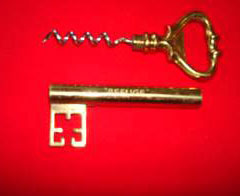 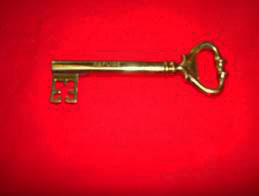 |
When a guest had spent 21 nights at The Refuge, he/she became a Refugee. Amidst a great deal of fuss, noise and clinking glasses, they would be presented with a “gold” key. On one side of the barrel was inscribed “21” and on the other “Refuge”. The top of the key was a bottle top remover, while if you pulled that away from the barrel it provided you with a cork screw. The key was laid on a red velvet cushion and was generally presented by Kenny after the new Refugee had made a fool of themselves as such “singing for their supper”.
My experience of a Friday night at The Refuge was to make your bed as soon as you arrived, then into the Wardroom to open the bar. This was a great ritual, with a bell being sounded at 6.00 pm and the prettiest girl appointed barmaid. Armed with drinks, the Daily Telegraph quick crossword would be done in record time, and then we would be summoned in to dine. Dinners were always a main course of very simple dishes followed by a dessert. Rarely was wine served. When the meal was over, Kenny would say “Unexpired rations this way” and all unused cutlery would be handed to him which he would leave in a neat pile for Elefteria to deal with. After dinner, we would return to the Wardroom where card games and board games would be played. Quite often charades were on “the menu” too. There was never any drunkenness and most were heading towards their sleeping quarters by 11 pm.
Depending on the time of year, breakfast would be either in the dining room or on the Bati. Again, depending on the season and weather conditions, the day would be spent going for a walk, a trip on the Bati, fishing and generally being sociable. These events were, of course, punctuated by the ritual of drinks at lunch time and then again in the evening.
By today’s standards of living, this may not sound terribly exciting, but we had so much fun that recalling those wonderful days to write this up is like having lived it yesterday.
Betty Ann (Whittall) McKernan
26 February 2013
Notes: 1- Ms McKernan has collaborated extensively in the ongoing map and historical property analysis project undertaken by George Vassiadis and some of the findings can be seen here:
2- A cousin of Ms McKernan, John Whittall has transcribed his late father’s (Geoffrey Whittall 1906 - 2003) writings, kindly provided for this website in July 2014, covering the early Whittall and allied families’ history in Turkey.
3- Our Levantine Heritage, an address given by David Whittall on the occassion of the second Descendants of the Whittalls of Turkey Family Reunion, London 19 September 2015, organised by Betty McKernan.
4- Ms McKernan was also instrumental in updating the Whittals of Turkey genealogy in 1996 and organising the family descendants reunion in 1999 in London and has kindly provided this account of that time here, penned in 2015:
5- Memories of Kenny Whittall penned by David Cheesman, the son of the British Consul of Istanbul during the 1960s - May 2016.

